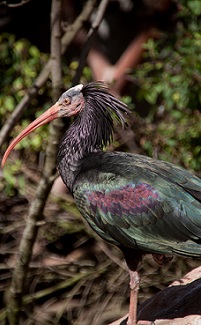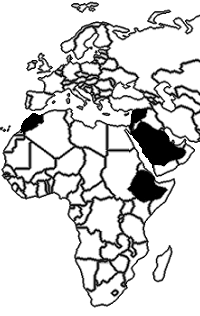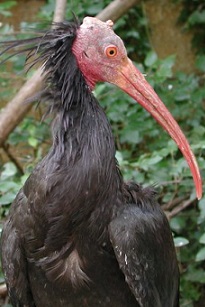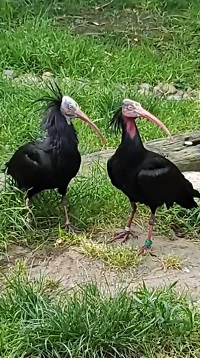Waldrapp Ibis
Geronticus eremita
- Habitat: open dry areas, coastlines, cliff ledges
- Range: Southern Morocco, Syria, North Africa
- Natural Diet: Insects, small reptiles, worms
- Status In The Wild: THREATENED
All about the Northern Bald Ibis
Northern bald ibises are large birds with glossy black feathers streaked with iridescent bronze, emerald, and violet visible when they are basking in the sunlight. They have no feathers on their heads, giving them their name. They have pale red bills and heads and their napes are covered with thin, long black feathers that stand out, on occasion, like a crest. The Northern Bald Ibis is closely related to other species of ibises, spoonbills, and herons. They also share some similarities with pelicans, shoebills, and hamerkops. But unlike most of these species, Northern bald ibises do not wade water in search of food. They live on steep mountainsides, cliff ledges and outcrops where they build their nests. Also. These ibises are considered to be larger birds being around 2.5 feet with a wingspan of up to 4.5 feet. They weigh 2.5 to 3 pounds. They are monomorphous with males and females having similar plumage, shape, and form.
Diet/ Habitat/ Range
Northern Bald Ibises are found in west Asia
(Syria, Saudi Arabia, Yemen, Jordan, and Turkey) and northern Africa
(Algeria, Morocco, Eritrea, and Ethiopia)
These ibises mainly feed on small mammals, small birds, reptiles,
insects, worms, spiders, and fish.
Behavior
Northern bald ibises are known to be colonial nesters and nest next to each other. By nesting together in a colony, they reduce the likelihood of their family group being predated upon. This evolutionary trait is considered an anti-predator strategy. These ibises maintain and defend home ranges in which, they feed, rest, and protect their young. They use their long curved bills to hunt for food probing their bills into mud and soil in search of insects, fish, and worms.
These ibises emit a variety of vocalizations. The mating or “croop” call is emitted during courtship. Similar calls are emitted when birds greet each other. They also emit a loud and shrill alarm call to alert the colony to the presence of a predator.
Reproduction
Northern Bald ibises are monogamous with the females selecting single male partners that they pair and breed with for life. The male ibises build a nest of grass, twigs, sticks, and dried leaves depending on the habitat in which they live. The nest is significantly important since the female will select her mate depending on the nest he has built. During this process, the male displays courtship behaviors also vocalizing with the mating “croop” call. If successful, the pair get together and they will breed. Females can lay up to two clutches of eggs in a breeding season. A clutch consists of 3 or 4 eggs. Both males and females incubate eggs and feed their chicks (biparental care). The chicks fledge when they are about 2.5 months old and are able to fly. They start feeding themselves at four months and reach sexual maturity between three to five years of age.
Conservation/Status
Approximately 249 Northern Bald Ibises are living in the wild today. They are categorized as CRITICALLY ENDANGERED by the World Conservation Union because of the serious threat to their population numbers from urbanization and habitat encroachment due to farming (in Morocco); illegal hunting, overgrazing, and collection of firewood (in Syria); and, poisoning and the utilization of pesticides (in Turkey).
The Association of Zoos and Aquariums (AZA) is focused on conserving Northern Bald Ibises through their Species Survival Plan (SSP). Zoos across the United States, Canada, and Mexico are involved in their program and several are selected to breed their ibises to increase their population in the zoo community. AZA’s SSP is also linked with other zoos globally and several individuals have been moved internationally to add new genes to increase genetic diversity. Several other countries such as Turkey and Germany where ibises went extinct are in the process of reintroducing Northern Bald Ibises to their native habitat.




